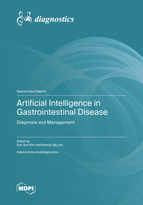Artificial Intelligence in Gastrointestinal Disease: Diagnosis and Management
A special issue of Diagnostics (ISSN 2075-4418). This special issue belongs to the section "Machine Learning and Artificial Intelligence in Diagnostics".
Deadline for manuscript submissions: closed (30 September 2022) | Viewed by 41273
Special Issue Editors
Interests: gastrointestinal disease; gastric cancer; colon cancer; inflammatory bowel disease
Interests: artificial intelligence; machine learning; deep learning; health informatics
Special Issues, Collections and Topics in MDPI journals
Special Issue Information
Dear Colleagues,
For every ten adults in the world, four suffer from gastrointestinal disorders of varying severity. Early diagnosis might be the best way to prevent and treat serious gastrointestinal diseases. Recently, attempts to use artificial intelligence (AI) for the early diagnosis of such gastrointestinal diseases have been explosively increasing, and it is reported that the potential is very promising. Therefore, we intend to publish a Special Issue on the diagnosis, treatment, and management of various gastrointestinal diseases such as GI tract cancer, inflammatory bowel disease, and endoscopy using AI technology, including various deep learning techniques.
Prof. Dr. Eun-Sun Kim
Prof. Dr. Kwang-Sig Lee
Guest Editors
Manuscript Submission Information
Manuscripts should be submitted online at www.mdpi.com by registering and logging in to this website. Once you are registered, click here to go to the submission form. Manuscripts can be submitted until the deadline. All submissions that pass pre-check are peer-reviewed. Accepted papers will be published continuously in the journal (as soon as accepted) and will be listed together on the special issue website. Research articles, review articles as well as short communications are invited. For planned papers, a title and short abstract (about 100 words) can be sent to the Editorial Office for announcement on this website.
Submitted manuscripts should not have been published previously, nor be under consideration for publication elsewhere (except conference proceedings papers). All manuscripts are thoroughly refereed through a single-blind peer-review process. A guide for authors and other relevant information for submission of manuscripts is available on the Instructions for Authors page. Diagnostics is an international peer-reviewed open access semimonthly journal published by MDPI.
Please visit the Instructions for Authors page before submitting a manuscript. The Article Processing Charge (APC) for publication in this open access journal is 2600 CHF (Swiss Francs). Submitted papers should be well formatted and use good English. Authors may use MDPI's English editing service prior to publication or during author revisions.







